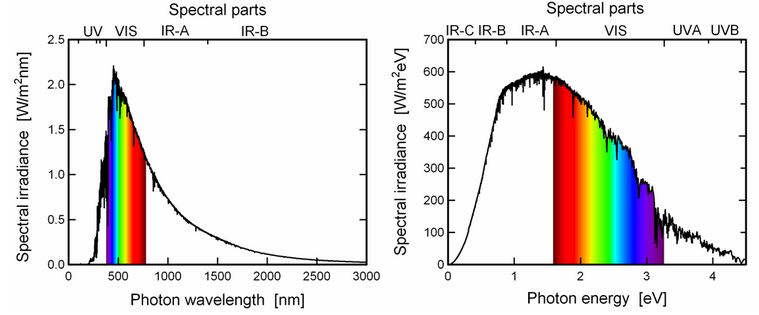Question
How can I calculate energy output?
Not too reliably.
You start from the energy actually incoming on the panels. This is the total solar irradiance and is the black body radiation given off by the Sun. It actually depends on several factors, so a star "identical" to the Sun might be off by up to 5% either direction (the Sun is itself a weakly variable star, by about 0.09-0.15% depending on the source).
For the Sun that value is around 1365 W/m^2.
Now, the problems are the following:
- your solar panels (any solar panel) will only capture a fraction of that energy, if we're talking photovoltaics, because the photovoltaic effect requires photon of a precise wavelength or, at the very least, some specific frequency bands.

To improve the yield you can re-radiate some waste heat, mainly due to the longer wavelengths in the infrared, through some Seebeck converters. But that adds to the mass and complexity of the station.
- That energy will not be converted with 100% efficiency. You're probably looking at around 20-40% if using photovoltaics.
There is talk of "quantum traps" rectennas made up of microscopic crystal "hairs" (a previous version employed carbon nanotube 'hairs') pointed towards the Sun, organized in such a way that an incoming photon would always pass through a hair-gap "tuned" to steal its energy, no matter what frequency it was. But even the theoretical efficiency for this setup is not 100%, but around 90-95%, because it depends on the re-radiation temperature of the panels; to achieve 100% you would need to cool them to absolute zero, and that would take energy... .
Conversion and storage efficiency. The panels will produce electricity at some optimum voltage, then you'll have to smooth, buffer and convert this energy to "pair" it to whatever uses it. Possibly you'll have to store it into batteries or capacitors and retrieve it later. All these operations will waste a percentage of the available energy.
Wear and tear. The panels are exposed to hard radiation and charged particles from the sun, and this is hard on many materials. Glass will slowly become more opaque, semiconductor junctions will slowly "corrupt". The decay rate for the ISS Solar Array Wings is around 3% each year.
A reasonable, back-of-a-napkin calculation for energy yield would be around 400 W/m2. Having 6000 m2 available will then give you around 2.4 megawatt of power, and I think you can rely on two solid megawatts for most purposes for any reasonable time frame.
Of course, inconveniences like severe coronal mass ejections and charged particle onslaught, high-speed meteoric dust or even, Lord forbid, Kessler syndrome could easily reduce available power either gradually or even catastrophically.
A way to increase the yield and durability of the setup could be to set up the panels facing away from the Sun, and use a micrometer-thick Fresnel mirror to concentrate the radiation on the panels. The mirror would protect the panels, and it would be easier to replace; possibly it could even be self-healing (a corroded area of the mirror could be re-melted to erase pocks and scratches). Of course, the mirror performances in a vacuum then might become a problem.